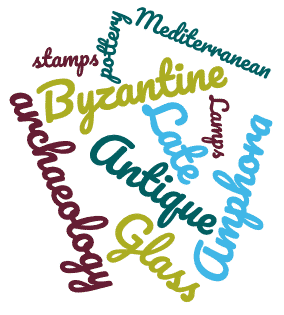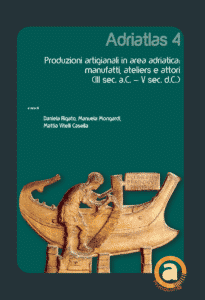UN@ est une plateforme d'édition de livres numériques pour les presses universitaires de Nouvelle-Aquitaine
Auteur : Ilaria Bandinelli
Ilaria Bandinelli is post-master student.
- 2016: Bachelor’s degree at University of Florence in History and protection of Archaeological and Cultural Heritage (max. vote 110/110) with the thesis: “Le anfore della ricognizioni di Podere de Stefano, Populonia (LI)” (= “The amphorae from the surveys at Podere de Stefano in Populonia (LI)”), supervised by professor De Tommaso Giandomenico (Roman and Greek archeology).
- 2018: Master’s degree at Universiy of Bologna in Archeology and Cultures of the Ancient World (max. vote 110 with honors) with the thesis: “I contenitori da trasporto dallo scavo del quartiere abitativo di via D’Azeglio a Ravenna” (= “Transport containers from the excavation of the residential area of via D'Azeglio in Ravenna”), supervised by professor Baldini Isabella (Late Antique and Byzantine Mediterranean archeology).
- 2021: Diploma’s degree at Specialistic Italian School in Archeology at University of Bologna, curriculum late antique – medieval (max. vote 110 with honors) with the thesis: “La produzione vetraria a Gortina di Creta tra il IV e il IX secolo” (= “Glass production in Gortyn of Crete between the 4th and the 9th century A.D.”), supervised by professor Baldini Isabella (Early Christian and Byzantine archeology).
Archeological projects and excavations
- From 7/07/14 to 19/07/14: Archeological excavation at roman villa of “Poggio del Molino”, Populonia (LI). Scientific supervisor: prof. De Tommaso Giandomenico, dr. Megale Carolina.
- From 20/10/14 to 1/11/14: Archeological excavation for a late antique context at “Piazza Garibaldi”, Fiesole (FI). Scientific supervisor: prof. De Tommaso Giandomenico, dr. Megale Carolina.
- From 8/07/15 to 20/07/15: Archeological excavation at roman villa of “Poggio del Molino”, Populonia (LI). Scientific supervisor: prof. De Tommaso Giandomenico, dr. Megale Carolina.
- From 9/07/16 to 17/07/16: Archeological excavation at roman villa of “Poggio del Molino”, Populonia (LI). Scientific supervisor: prof. De Tommaso Giandomenico, dr. Megale Carolina.
- From 9/06/17 to 19/06/17: Archeological excavation at Basilica of Agios Stephanos, Kos (Greece). Scientific supervisor: prof. Baldini Isabella.
- From 4/09/17 to 17/09/17: Archeological excavation at Pompei (NA). Scientific supervisor: prof. Coralini Antonella.
- From 7/09/18 to 28/09/18: Archeological excavation at Mitropolis basilica, Gortyn (Crete). Scientific supervisor: prof. Baldini Isabella.
- From 12/11/18 to 24/11/18: Archeological excavation at necropoli di Chiaramonte Gulfi (RG, Sicily). Scientific supervisor: prof. Baldini Isabella.
- From 13/05/19 to 2/06/19: Archeological excavation at necropolis of Chiaramonte Gulfi (RG, Sicily). Scientific supervisor: prof. Baldini Isabella
- From 9/09/19 to 21/09/19: Archeological excavation at Mitropolis basilica, Gortyn (Crete). Scientific supervisor: prof. Baldini Isabella.
- From 8/10/19 to 19/10/19: Archeological excavation at necropolis of Chiaramonte Gulfi (RG, Sicily). Scientific supervisor: prof. Baldini Isabella.
- From 24/11/19 to 30/11/19: Archeological survey (field survey) in Croatia, at Parenzo (Porec) with the Italian Graduate School in Archeology of Bologna.
- From 16/08/20 to 13/09/20: Archeological excavation in Ancient Messini (Movrommati, Messini, Greece), at the so called “βασιλικής του Ασκληπιείου”. Scientific supervisors: prof. Georgios Deligiannakis, prof. Nikos Tsivikis, emeritus prof. Petros Themelis.
Activities & Congress
- From 2017 – in course: Attending the discussion group: “Byzantium and the Eastern Mediterranean” (BOM), coordinatated by professors Cosentino Salvatore and Baldini Isabella.
- From 2018 – in course: Part of the research team at Basilica of Mitropolis in Gortyn (Crete).
- From 28/10/19 to 31/10/19: Attendance at III Congress of CISEM (Centre for Studies on Late Antique Housing in the Mediterranean), title of relation: “Materiali lapidei, ceramici e pittorici dal quartiere abitativo di via D’Azeglio a Ravenna. Risultati preliminari. 2.1. Le anfore. Le lucerne” (= “Marbles, pottery and frescoes materials from the residential area of via D’Azeglio in Ravenna. Preliminary results. 2.1. The amphorae. The lamps”).
- From 2019 – in course: Member of CISEM (Centre for Studies on Late Antique Housing in the Mediterranean).
- October 2019: collaboration in setting up the exhibition with new panels at the “Domus dei Tappeti di Pietra” in Ravenna.
- From 2020 – in course: take part to the project StartUp “DIG-ITAL-PEN”, a scanner-hardware-software that permits the digitization, recognition and reconstruction of archeological material objects.
- From 01/06/20 to 31/07/20: internship at the Ravenna-Forlì-Cesena archeological Italian Ephorate. Work on the QGIS database related to the archeological evidences of the city of Forlimpopoli (FC).
- From 2020 – in course: Part of the archeological team at “βασιλικής του Ασκληπιείου” (Ancient Messini, Mavromati, Greece).
- Attending the 22° Congress of AIHV (Association International pour l’Histoire du Verre), 13-17 September 2021 Lisbon, Portugal. Title of relation “Glass production in Gortyn of Crete between the 4th and the 9th century A.D.”
- Archeologia tardoantica e protobizantina nel Mediterraneo: progetto Kos
- Archeologia tardoantica e protobizantina nel Mediterraneo: progetto Mitropolis
- Archeologia tardoantica e protobizantina nel Mediterraneo: progetto Koschiaramonte Gulfi
- Archeologia tardoantica e protobizantina nel Mediterraneo: gruppo di discussione
- Abitare a Ravenna: Le domus di Via
Le ricerche condotte dalla Soprintendenza Archeologica dell’Emilia Romagna tra il 1993 e il 1994 in via d’Azeglio, a Ravenna, hanno portato alla luce un ampio complesso residenziale, collocato nel quadrante nord-occidentale della maglia insediativa urbana. Il contesto indagato, composto da nuclei abitativi affacciati su un asse viario dotato di un sistema di smaltimento delle acque, rappresenta un unicum nel quadro delle indagini sul centro ravennate, sia per collocazione topografica che per sviluppo diacronico.




